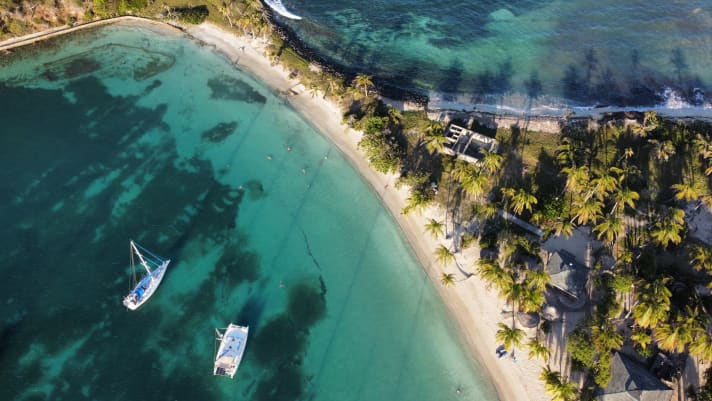Blue Water Blog: A year in the Caribbean: The sunny and dark sides of a sailing paradise
Martin Finkbeiner
· 18.07.2022
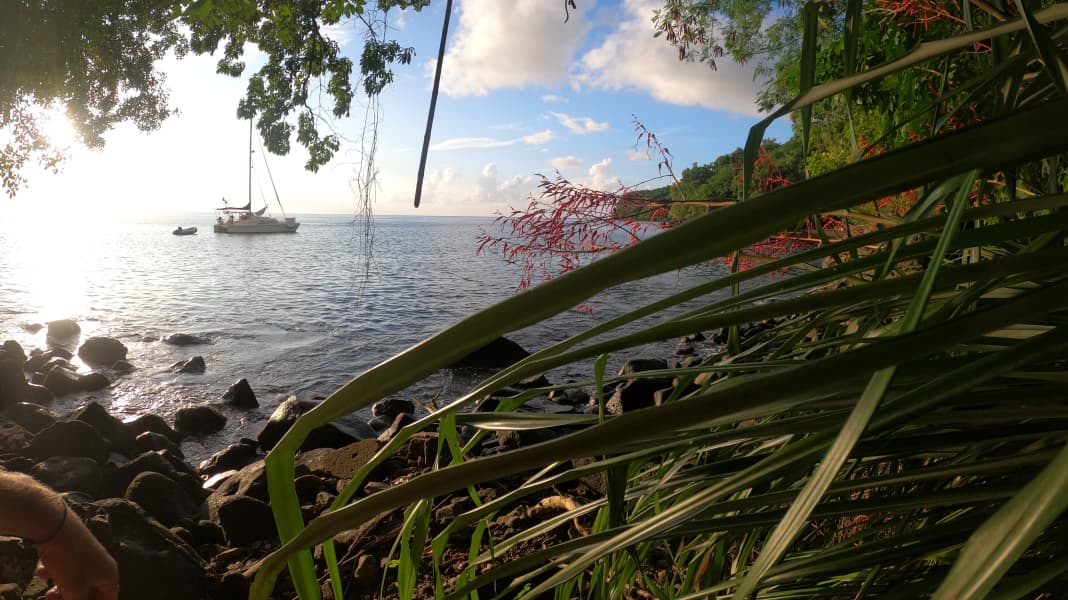
It is well known that there is no such thing as the perfect boat. Living space is often at the expense of sailing characteristics, and a boat for the tropics is often only partially ideal for the high latitudes and vice versa. A shallow draught and a large cockpit are great at anchor, but not necessarily in 40 knots of wind and four metre waves on the high seas.
When we sold our "Aracanga" and bought the "Snowgoose", a 37-foot catamaran from Prout, we realised that we were sacrificing sailing characteristics in favour of living space. But we also realised that 30 feet with a small child is too small in the long run. The Prout is considered to be very seaworthy and safe, which has been proven on numerous trips around the world in recent decades. So why not a catamaran?
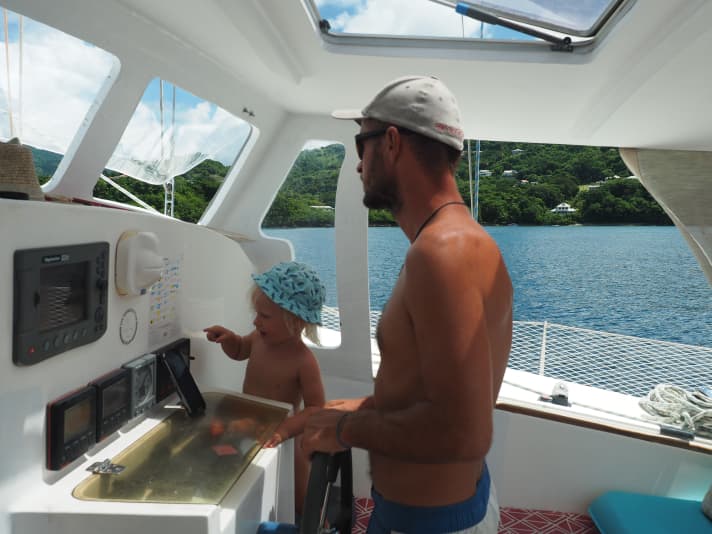
We scrape together all our savings, have to borrow some money from the family and set off on a new adventure, which at the same time also means a new phase in our lives: away from travelling and towards a (temporary) life plan. The little money we still have on the high edge goes into the boat. Boat instead of house, mobile instead of property, water instead of land. We are happy with our decision.
The first year with our new home should take us through the Caribbean. Areas like the Bahamas sound appealing. We now have the ideal boat for this shallow water area; with our 90 centimetre draught, bays and anchorages are open to us that we could previously only dream of. After a few months of hurricane season, boat work and disappointments, moments of joy and a lockdown, we can finally cast off.
Northwards along Grenada's west coast
As soon as the exit restrictions allow, we say goodbye to our anchorage off Hog Island, where we have spent six months, and slowly sail northwards. For now, we decide to sail in short stages along the west side of Grenada and make a few stops along the way.
First we head for St George's, the capital of Grenada. A jammed furling genoa turns the short journey into a motorised instead of a sailing trip. The problem is quickly solved, the sail is set on the wrong halyard. We hardly set sail for the next few days either, as the wind is very light.
Just a few miles to the north is the Underwater Sculpture Parc, which we visited a few months ago. Life-size sculptures by various artists are located here in just a few metres of water and are intended to serve as the framework for a new reef. The special structure of the surface is readily accepted by the polyps and you can clearly see that new corals are growing out of eyes, ears and noses, on heads, shoulders and arms. It is a fantastic, magical place, a symbiosis of art and active nature conservation. And above all, it is a small ray of hope that endeavours such as the sculpture park are bearing fruit.
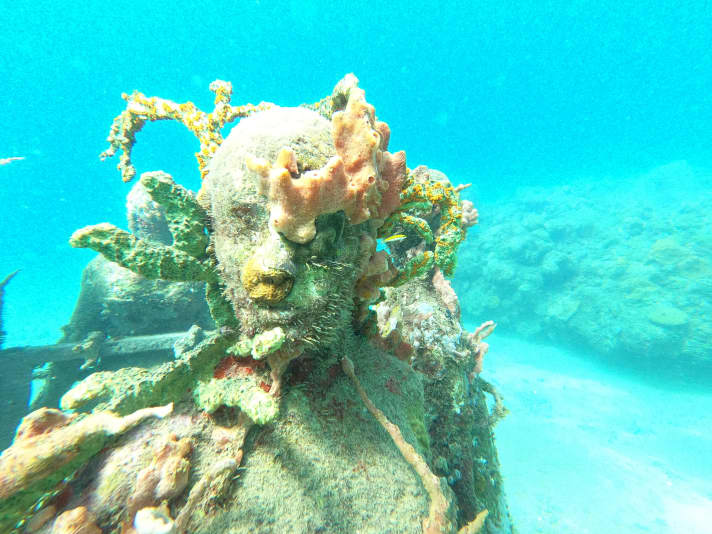
Just think, if we don't change anything fundamentally and radically, but carry on as before, most of the world's corals will have died within the next 30 years. As a family with one and soon two small children, this realisation is particularly painful. Showing the children the beauty of the world and creating the broadest possible awareness of precisely this fragile beauty is one of the aims of our trip.
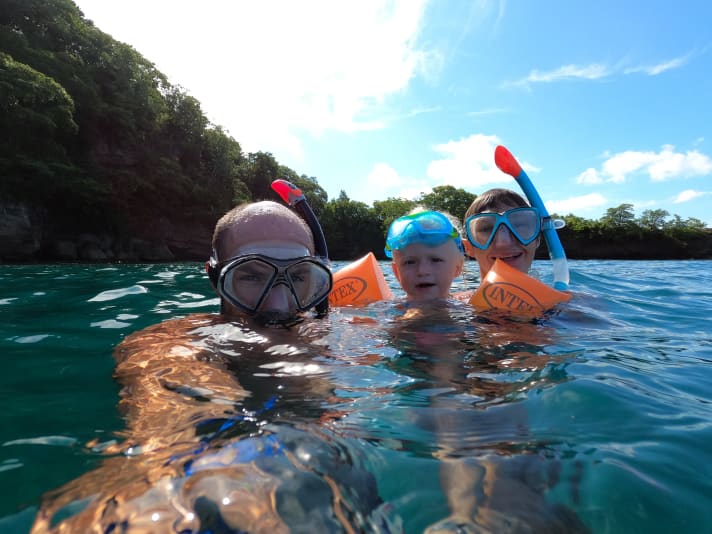
A short advert in passing: For this reason and on this subject, we have written a children's book in recent years, a fictional story with an all-too-true background about the exciting journey of a Klabautermann: "Elmo and the stolen blue".
We spend a night at one of the Sculpture Park buoys and sail a few miles further the next day. Our destination is Halifax Harbour, a sheltered natural harbour with a few wrecks and beautiful beaches in the west of Grenada. We drop anchor in two and a half metres of water in a small bay with a beautiful black sandy beach. We feel like we're on holiday. It's so nice to be travelling again after six months in the same place.
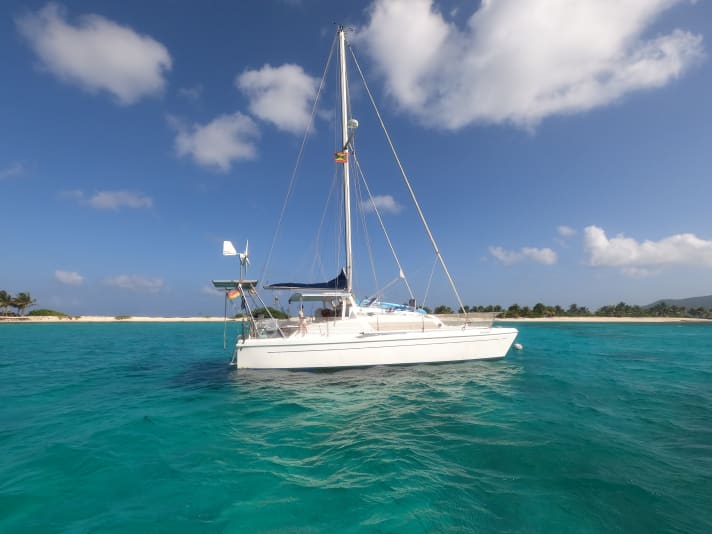
From Halifax Harbour we are drawn to the uninhabited Ronde Island and on to Carriacou. The first few miles are rough with a lot of current and a short, steep wave against us. However, the further we get away from Ronde and approach Carriacou, the calmer it becomes.
Carriacou
Carriacou is quiet and relaxed. The island is known for its reefs and the turquoise-coloured water that we have been looking forward to for so long. We spend three days here and meet up with a good friend of ours: the small, red "Aracanga", our old boat. Together we sail round the corner to Sandy Island, an island consisting of little more than a sandy beach and a few palm trees. Sandy Island is what you would imagine Caribbean kitsch to be: a flat island with a white beach on one side and a beautiful coral reef on the other. A few coconut palms grow behind the beach, the water shimmers in a light turquoise colour and pelicans, sea eagles and frigate birds circle and plunge into the sea in search of fish.
The entire area around Sandy Island and Sister Rock is a marine reserve, which means that no fishing, harpooning or anchoring is permitted. There are a few buoys on the leeward side of the island where we are allowed to moor and stay. We spend about a week on a buoy off Sandy Island and enjoy swimming and snorkelling, making a fire on the beach in the evening, baking bread over the embers and barbecuing, celebrating birthdays on the beach and, unfortunately, collecting a bag full of rubbish on the small island every day. Some of it is washed ashore, most of it is left lying around. Environmental protection is still far from being in everyone's minds.
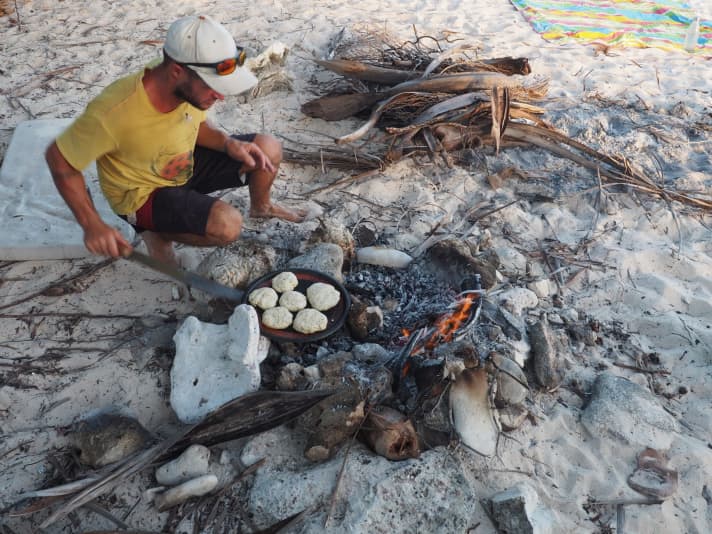
In the meantime, it's hard to miss the fact that Kira will have a baby brother or sister in a few months' time. We have to go back to Grenada for a check-up. We sail the 30 nautical miles from Sandy Island in half a day. The wind blows from diagonally astern - catamaran sailing is really fun.
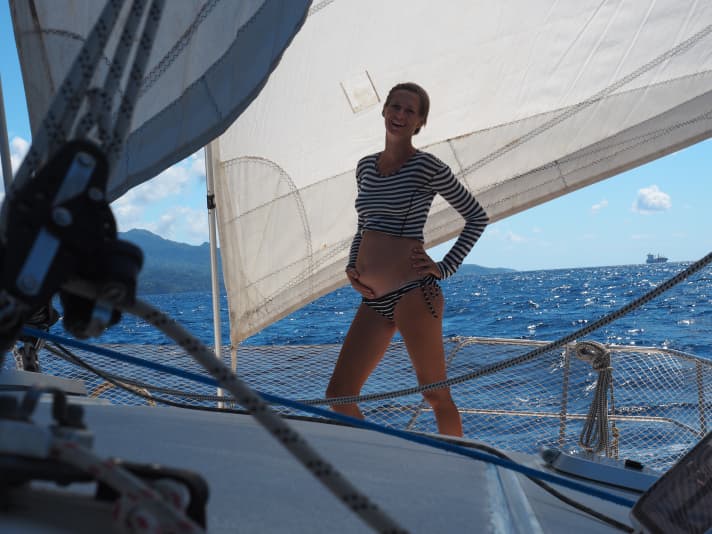
The doctor says that everything looks good and healthy. We are delighted and adapt our plans to the circumstances. There are two options: to fly home for the birth or to stay in the Caribbean. And there are a thousand factors that come into play: Family and finances, safety and insurance and, last but not least, the current Covid situation on both sides of the Atlantic. We're really looking forward to welcoming our new crew member and exploring the world's oceans with the gang of rascals over the next few years. As already mentioned, we have to seriously ask ourselves whether Kira and her future sibling will symbolise the next generation of whales and sharks, whale sharks and sharks, coral reefs and reef fish, or whether they will only know them from pictures and stories.
St Vincent and the Grenadines
The next day we want to sail to Union Island. The neighbouring island, which belongs to St. Vincent and the Grenadines, is only four miles away from Carriacou, but in Covid times everything is a little more complicated. We take a risk and clear out straight after the PCR test without knowing the results. Our visas are maxed out to the last day and we want to avoid paying fees for another month. As soon as we receive the negative test results we had hoped for, we make our way to Union Island, where we raise the yellow flag, the letter Q for quarantine in the flag alphabet, and go to one of the official buoys.
Shortly afterwards, a somewhat chubby, likeable and enterprising man comes alongside in his little speedboat, introduces himself as Buddha and, not paying attention, sells us completely overpriced banana bread. But he also registers us straight away and makes sure that we can clear in early the next day. This put the expensive price of the local pastries back into perspective. And it was delicious too. Immigration is quick and easy. Fortunately, we are spared the cost of another PCR test and the incomparable feeling of having our brains pulled out through our noses. The yellow flag goes down and the guest country flag of SVG now flies under the starboard dolphin.
Reunion on Union
"Where is he?" - "He always arrives in the dark." That's right. Whether Morocco, the Canary Islands, Cape Verde or Senegal, the "stray" always arrives shortly after sunset. And this time it's the same again. Shortly after dark, a small, familiar boat suddenly chugs into the lagoon next to us. A great reunion! Three years after our first meeting in Rabat, Morocco, and two years since we last saw each other, it's now Reunion on Union Island. After André has also cleared in the next day, we cast off the lines and sail round the corner to the quiet and beautiful anchorage behind Frigate Island.
The anchor drops to a depth of about one and a half metres of crystal-clear water, and apart from us, there are only two other boats at anchor: a French couple and - tada - the little red "Aracanga". And so not only the crews meet again, but also the boats that spent so much time together on the other side of the Atlantic in Africa. Days and evenings pass with coffee in the sunshine, rum punch in the moonlight and chatting about the experiences of the past two years.
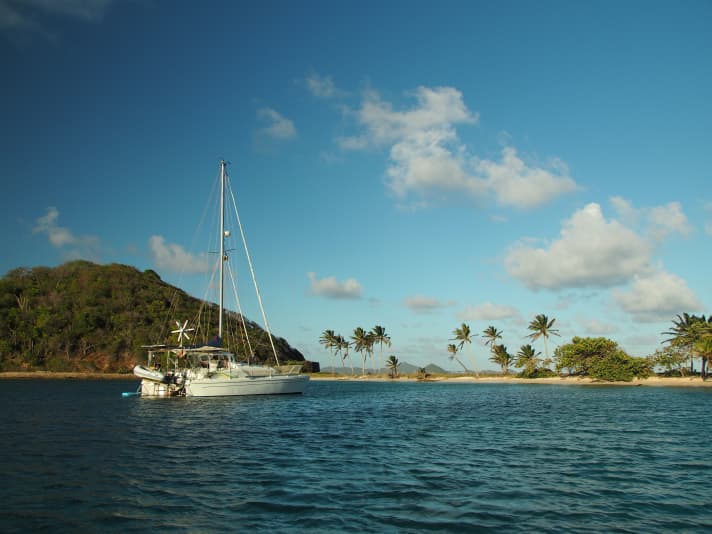
From Frigate Island, we sail around the western tip of the island into picturesque Chatham Bay. The bays become more and more Caribbean, the sandy beach whiter and the palm trees more numerous. We also stay here for two nights. As almost always, there is some work to be done, this time it is a leaking simmer ring on our watermaker that needs replacing and the underwater hull, which once again needs to be cleared of fouling.
From Union Island, it is again only a few nautical miles to the neighbouring island of Mayreau. The short crossing is rough and bumpy and the bow and the two prows repeatedly crash into the waves. Kira is in her favourite spot next to the steering wheel, having fun and shouting "Boom!" with every wave. The crashing of the waves is a sound that we have become very familiar with since we bought the catamaran and is still very suspect. A few "booms" later, tiredness sets in and the big lady takes the little lady to her bunk for her afternoon nap.
A few more "booms" later, a look round, a routine glance into the cabin and a quiet "Oh, sh...". Although only whispered, Riki is immediately alarmed, comes out of the bunk and looks at me. I look at the cabin floor. We both look at the cabin floor: The water in the saloon is about two centimetres high. A quick look at the two hulls: dry. Thoughts flash through my head: "Fresh water? Salt water? A crack in the laminate? Is the water coming into the bridge deck from the front?" Riki tries: "Salt water." Then again: "It tastes funny, but it's fresh water." Then we hear the pressurised water pump humming and immediately switch off the corresponding fuse. The fresh water has been pumped from the tank into the saloon via a burst hose connection. Annoying! But it's not so bad, we'll deal with it when we get there.
Mayreau
We wanted to tear out the old carpet in the lounge at some point anyway, so we did it straight away. It's a quick job, but it's more time-consuming to remove all the bits of glue that have stuck the carpet to the wooden floor. We work until Kira wakes up, then take a break on the beach and continue in the evening until all the adhesive residue has been removed. Fortunately, it rains heavily during the night and the next day the tank is almost half full of rainwater again.
Mayreau offers two picturesque anchorages, Saline Bay and Salt Whistle Bay. We spend a week in the former and over two weeks in the latter. With our 90 centimetre draught, we can almost reach the beach and lie in the shallow water. Behind the coconut palms at the narrowest point of the island, we can see the waves breaking on the reef on the windward side of the island from our super-protected, crystal-clear and turquoise-coloured anchorage.
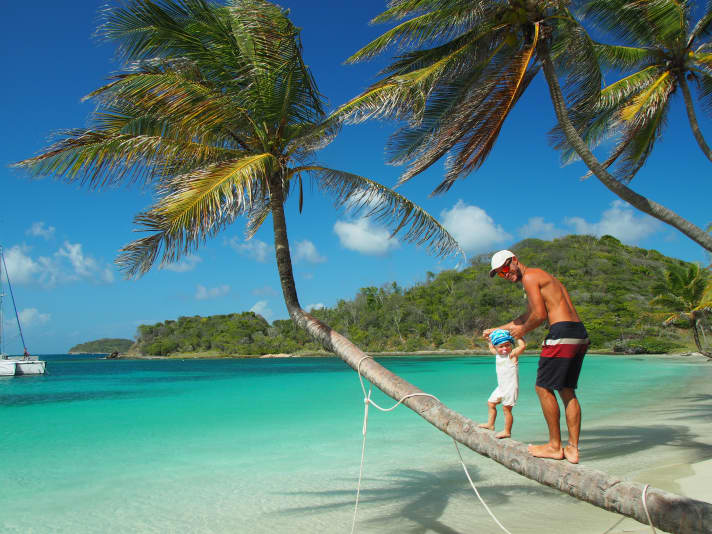
A few nautical miles further on are the Tobago Cays, probably the most famous rock piles in the eastern Caribbean. A dream. When we arrive, there are only two other boats in Salt Whistle Bay. However, as it is very windy, we are not the only ones to hide away in the calm bay. On the second night, the anchorage, which the cruising guide says is full of a dozen boats, has 24 other boats at anchor apart from us. But not small boats like us or the "Stray". They are all huge catamarans, 50 to 75 feet long, with big subwoofers and a wide variety of musical flavours. Almost always on board: Mr "Look at my oiled muscles" and Miss "Low-cut Instagram selfie".
Knowing that the cats will all leave again the next day, it is mainly amusing for us to watch the goings-on. Thanks to our shallow draught, we are a little away from the "danger zone" and only twice do we have to politely ask other boats anchored alongside us to reconsider their choice of anchorage. "That's fine, we can put out fenders" is the answer. Sometimes we get the impression that some of our contemporaries have a "me first" and "I can, because I'm insured" mentality. People, please be considerate of each other. Whoever comes last has to anchor further out or, in this case, move to the neighbouring bay just a mile away.
But as predicted, the spook is over the next day and the following nights there are usually only a handful of boats anchored in the bay with us. At least one boat has swerved into the neighbouring bay and arrives the next day in the empty Salt Whistle Bay: it's François Gabart and his family on a holiday sailing trip. He is the most successful single-handed sailor, Vendée Globe winner and the fastest solo circumnavigator with 42 days. We wouldn't have recognised him, but friends of ours drew our attention to him.
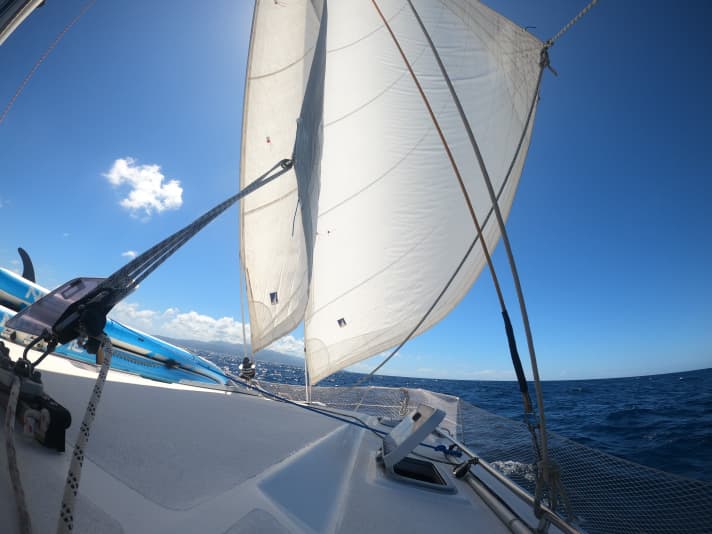
A little later, we paddle onto the beach with our SUPs, Kira points to the other children playing on the beach a few metres away, shouts happily: "There, kids", and runs towards them. This is how we meet the exceptional French sailor, who immediately hands Kira a shovel, introduces himself as François and says that he would like to live on a boat with his family one day, but will have to work for a few more years until then. We don't let on that we know him and we all dig in the sand together with the children.
From Mayreau, we sail on to Bequia with an overnight stopover on Canouan. It's supposed to be windy and rainy during the night, which is why we make the stopover. Another look at the weather forecast, then it's off to bed. Shortly afterwards, the first gusts come through and the current, rain squalls and downdraughts keep us turning round and round the anchor. We didn't get much sleep that night, as we hadn't expected the many wind shifts and turbulence behind the protruding cape. When the anchor starts to slip in the pouring rain at around two o'clock in the morning, it's quick: engine on, forward throttle, anchor up. And now that we're awake anyway, we can continue straight on to Bequia.
Christmas 2021 on Bequia
After six uncomfortable hours, the anchor drops again. We make coffee and jump into the water. Welcome to Admirality Bay in Bequia. Everything here gives the impression of a small, sweet, romantic, almost kitschy, intact world. A friend we meet again here remarks aptly: "It's like Bullerbü in the Caribbean." Bequia is a popular place to celebrate Christmas and New Year's Eve. Kira gets to know her little mate Sam, and together they romp on the beach every day. Before long, Kira is talking about nothing but Sam and how she absolutely and urgently needs to swim to the beach to play in the sand with Sam. That's fine by us, because we become good friends with the half-local, half-Scottish parents and celebrate Christmas together on the beach.
At the local beach bar, there is simple but delicious food served on a table that has been crudely nailed together for Christmas with stools made from sandbags. Kira is given an inflatable fish, a colouring book and some Duplo bricks. She spends the rest of the evening climbing onto the back of the fish with Sam and jumping into the sand, screaming.
Off to Martinique
On Boxing Day there is a good weather window to sail the 100 miles or so to Martinique, where our mate André is stuck with a lady visitor on his "stray" with a faulty cylinder head gasket. We set off in an easterly wind with a wonderful 15 knots. We sail past St Vincent and Saint Lucia, and after the many headwinds of the last few weeks, it is a pleasure to be travelling in a half-wind and with few waves. Our "Aracanga 2" does a marvellous job and steers itself for long stretches. Sailing on the catamaran is finally fun. We sail between the islands at a speed of six to seven knots, but in the lee of the islands we occasionally have to switch on the engine to make the most of the short, favourable weather window. The next day is forecast to be calm at first and then back to 20 knots.
Martinique
And suddenly we are back where our journey began in 2018, in France. Between Christmas and New Year's Eve, we arrive in the large bay of Le Marin on Martinique after a wonderful crossing at dawn. The island, which belongs to the EU, lies roughly in the centre of the Lesser Antilles and is the most populous of the archipelago. And it's not just people, there are plenty of boats here too. Kira is still asleep when we slowly enter the bay at dawn. At first we only see three masts, so this must be the anchorage. A short time later, we find ourselves in a swarm of hundreds and hundreds of people at anchor and have the feeling that we can't find a way out of the maze of boats.
At short notice, we decide not to anchor here off Saint-Anne in the outer part of the bay, but to continue the short distance to Le Marin, where the ladies' visit and the defective cylinder head gasket are waiting. At around six o'clock, the sun has not yet risen, and we are moored next to the small, turquoise-coloured boat. "Beautiful is something else" is the first impression, but it's still nice to be here. A short time later, the sun rises glowing on the horizon and sends the first warm rays on board.
We stay in Le Marin for three days. It's not beautiful, but it's practical. Food is very cheap in Martinique compared to the other islands in the Antilles, and you can also find a lot of other things you wouldn't find in the rest of the Caribbean. The first trip to the shops is a bit of a culture shock, as we are more used to kiosks than supermarkets from our many months in Grenada and Saint Vincent. Suddenly we're paying in euros again, even though we're in the middle of the Caribbean, getting baguettes and croissants from the bakery around the corner and calling our German mobile phone number. If we didn't know that we'd sailed many miles across the Atlantic to get here, we'd think we were somewhere in the south of France on the Mediterranean.
On New Year's Eve, we first tow our friends to Saint-Anne in our dinghy and then also sail the short distance to the equally crowded but far more beautiful anchorage. We then prepare for the evening, making salads, mixing sauces and preparing desserts. In the evening, several friends come on board. The barbecue is sizzling. Kira, whose favourite pastime is handing out drinks from the fridge, fills us all to the brim over the next few hours. At eight o'clock, there is a big firework display at close range, which causes many "ohs" and "ahs" and leaves the smallest crew member with wide-open eyes and mouths in amazement. The time until twelve o'clock passes quickly, beer is followed by wine, followed by rum and no sign of fireworks at the turn of the year. But it doesn't matter, it was perfect the way it was, a great evening for everyone and a lasting and impressive experience, especially for Kira.
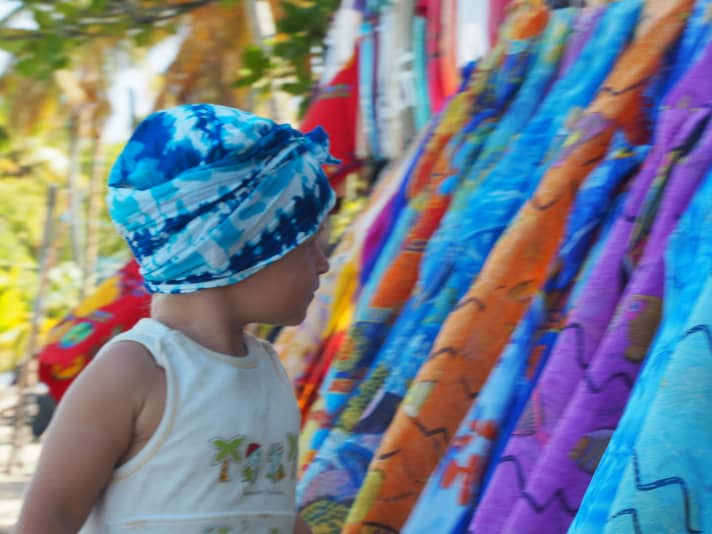
In the days after New Year's Eve, we spend a lot of time thinking about the coming months. We sailed to Martinique with the plan to stay here for the birth of Kira's sibling. But we haven't decided 100 per cent yet, there are many reasons to stay here and many reasons to fly home. After some back and forth, we decide to book flights to Germany and fly home for three months. On the one hand, we find it difficult to leave the boat alone in Martinique for so long and to travel from the Caribbean warmth to the southern German winter, but on the other hand, and this outweighs everything else, we are really looking forward to seeing family and friends.
Home leave: cold, but nice! It's nice to see lots of friends again and, of course, especially our family. At the same time, we are also really looking forward to our cosy life on our little floating home. Kira feels the same. She enjoys the days, playing for hours with her cousins and making new friends. But in the evening, when her battery is empty, homesickness strikes. Funnily enough, homesickness for Kira is the opposite of what it would be for us. For Kira, it's homesickness for the boat. After a long day of adventures on land, she lies in bed and talks about the "Aracanga", about swimming or about how Kira wants to take the dinghy to the beach tomorrow.
And suddenly there are four of us. Yes, although a pregnancy like this lasts nine months and you would think that nine months would be enough time to adjust to what is to come, everything happens quite suddenly. At the beginning of April, we hold our daughter Naia in our arms. The name Naia has several origins and meanings, but they all have one thing in common: water. In Hawaiian, the name Naia means dolphin, in Basque it means wave, and in Greek it refers to the naiads, the water nymphs. We heard the name for the first time at Christmas on Bequia, Kira's little mate Sam's aunt is called Naia.
Our holiday home is soon over and we make the long journey back to our boat. Although we are used to saying goodbye due to our travelling lifestyle, this farewell is particularly difficult.
Back on board
After an adventurous journey by train, plane, taxi and dinghy, we arrive safely back in Martinique. We spend the next few days settling in on board. Shopping, filling water tanks, tidying up, cleaning up, pumping up the dinghy. We all have to get used to life on board and the heat again. It's nice to be back on the boat, it's wonderful to be here with the four of us now, but it's also a challenge with two small children.
Fortunately, the faint doubts that sometimes quietly creep in during the first few days of chaos quickly fade away and we find our feet. It's a question of attitude, the focus has clearly shifted to the children.
A cat for a year
We've had our new boat for a year now, and to be completely honest, the catamaran is not the boat we're happy with in the long term. It's a great boat, it offers space and opens up places that would have remained closed to us with our old "Aracanga".
Nevertheless, as far as sailing is concerned, we don't warm to a catamaran. We miss the smooth movements of the monohull when the boat dives into the waves, simply the feeling of sailing. What's more, in the next few years we want to head for colder regions as well as warmer ones, for which we need things like an appropriate diesel capacity, also to be able to operate a heating system. For these reasons, we have decided to sell the cat and look for a mono again. And if we're going to take this step, it only makes sense to do it now. Because as soon as we leave the Caribbean for the Pacific, the boat market will become scarcer and more expensive.
While still in Germany, we put our "Aracanga 2" up for sale. After about two weeks in Martinique, we sail back to Grenada in one go, where we already have a monohull in mind. The weather forecast promises a calm and relaxed crossing - 15 knots of wind and one to one and a half metre waves - a weather window that we are happy to take advantage of. In the morning, we sail out of the large bay of St Anne in the south of Martinique and set a course of 200 degrees. In the lee of the islands of St Lucia, St Vincent and the Grenadines, we sail south in good conditions. Only at the northern and southern tips of the larger islands is there a little more current and a more unpleasant wave, but all in all the 155 nautical miles to Grenada, which take us just over a day, are pleasant to sail. At dawn we are across Canouan, and in the course of the morning the silhouette of Grenada comes into view. We start the engine for the last few miles in the lee of the island and at 4 p.m. we are moored at a buoy off Saint George's, the capital of Grenada.
Fortunately, we no longer need Covid tests to enter the country, so clearing in the next morning is quick and uncomplicated.
Back in Grenada
Now we are back where we were a year ago: back in Grenada. And once again we are selling and buying a boat, but this time not for the sake of space, but for the sake of sailing. We are the exotic family switching from a cat to a monohull. Other families we know take the opposite approach, citing the space and comfort argument: "You spend 90 per cent of your time at anchor, so the sailing characteristics don't matter."
We know and understand the argument, but we give more weight to the counter-argument: "We only spend ten per cent of our time sailing, so we want it to be as memorable as possible." Yes, the cat was a good time, a good experience, and it is definitely a good boat that we have taken to our hearts. But as I said, it's not the boat for us in the long term.
Further information, pictures and articles about the voyage of the "Aracanga" at Ahoy.blog
